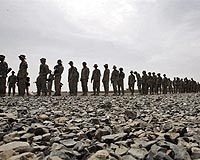| . |  |
. |
Islamabad (AFP) May 8, 2009 Pakistan may have superior military might, but to win the war against Taliban guerrillas they must avoid collateral damage and rebuild angry lives shattered by the offensive, analysts say. Militants are believed to have a strong presence in more than half North West Frontier Province, despite military operations over the past two years, on top of six years of battles in the surrounding semi-autonomous tribal belt. The army has lost more than 1,500 soldiers since 2002 and has claimed to have killed thousands of rebels, yet the Taliban have continued to advance. It has been a deadly fight -- difficult militarily to fight guerrillas on remote, rugged mountainous terrain and difficult politically to wage battle against fellow Muslims, particularly if civilian casualties soar. Pakistan has a conventional standing army of around 700,000 troops and traditionally considers India its main threat. The military press wing says 100,000 are deployed on the eastern front in the border areas with Afghanistan. It remained unclear whether large numbers of troops based in the provinces of Punjab and Sindh, on the Indian border, would be diverted to what President Asif Ali Zardari has called a fight until a return to "normalcy". A senior military official, who wished to remain anonymous, told AFP that the security forces were adapting to the new challenge, which Washington has branded a danger to the very existence of the nuclear-armed state. "It is true that for a conventional threat, a conventional force was prepared, but the army has full capability to analyse the threat and adapt itself to deal with the changing threat," he said. "A lot has changed in terms of the army's orientation towards fighting militancy, mostly in the northwestern region, and they are now better trained and equipped to meet the challenge." Analysts recognised that it would be a bloody war, but said the root of success lay with the political authorities moving in when the battle was done. "There is going to be a lot of bloodshed," said defence analyst Talat Masood, a former army general. "Insurgency is different to full-fledged war. We face our own people fighting against us, and we have to employ different tactics," Masood said. Thousands of civilians have fled the current areas of major combat -- in the districts of Buner, Lower Dir and Swat -- which would ease civilian deaths. Without a post-war strategy, analysts say, public opinion against the government and army in the northwest will sour, strengthening the militants who want to impose their harsh brand of Islam across swathes of Pakistan. "The army is capable of quelling the insurgency in a few weeks, but then the political leadership will have to come forward and adopt a prolonged strategy to consolidate the military's win with rehabilitation," Masood told AFP. Helicopter gunships, fighter jets, tanks and artillery have been mobilised for the fierce onslaught, which began late last month after the Taliban advanced from Swat into Buner and Lower Dir despite a February peace deal. The military says up to 5,000 "battle hardy" militants are active in Swat, including Pashtun tribesmen and splinters of a hardcore Sunni organisation traditionally fighting for independence in Indian-administered Kashmir. Ikram Sehgal, an independent defence analyst, said Pakistan's armed forces lacked counter-insurgency equipment such as night-vision capabilities and technology to jam insurgent radio signals. "The army has acquired its counter-insurgency experience not through training, but on the job," he said. Sehgal estimates the army could take up to two months to conclude its campaign, despite the long operations to date so far, but said the authorities must quickly stem growing anti-military sentiment among the displaced. "This operation will bring collateral damage in the area which requires more than 10 times the money of the one billion rupees (12 million dollars) the government has announced -- one billion rupees is peanuts," he said. In a camp for the displaced in the Swabi district, people are keen to return home, but have no idea what the future holds. "People are frightened that when the army withdraws again the Taliban will come back," said 20-year-old camp resident Roshan Zari. Share This Article With Planet Earth
Related Links News From Across The Stans
 In Afghan 'desert of death,' a giant US military base emerges
In Afghan 'desert of death,' a giant US military base emergesCamp Leatherneck, Afghanistan (AFP) May 8, 2009 In the forbidding Afghan desert, US engineers are carving out a sprawling military camp as part of a dramatic American troop build-up designed to confront Taliban insurgents. The desolate plain in southern Helmand province that Afghans call the "desert of death" has turned into a hive of frenetic activity, underscoring President Barack Obama's decision to expand the US military commitment to ... read more |
|
| The content herein, unless otherwise known to be public domain, are Copyright 1995-2009 - SpaceDaily. AFP and UPI Wire Stories are copyright Agence France-Presse and United Press International. ESA Portal Reports are copyright European Space Agency. All NASA sourced material is public domain. Additional copyrights may apply in whole or part to other bona fide parties. Advertising does not imply endorsement,agreement or approval of any opinions, statements or information provided by SpaceDaily on any Web page published or hosted by SpaceDaily. Privacy Statement |